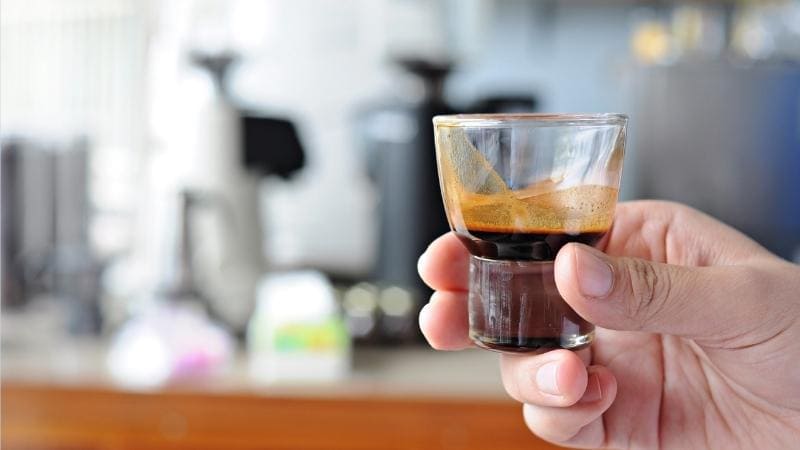
Corto means “short” in Spanish. In the context of coffee, Corto coffee refers to a short (restricted) shot of espresso; basically, this means that the barista only pulls the first part of a full-length espresso shot.
Caffe Corto is the standard espresso, around 30-50 milliliters in a single-serving cup. Caffeine content ranges from 30 to 60 mg, depending on the preparation method (e.g., Moka pot vs. espresso machine, Turkish vs. regular).
Corto is also known as a short coffee, which accurately describes its flavor. In actuality, it is a Ristretto, which is a popular thick brew that is smaller in size than an espresso.
The exact quantity of coffee used in making an espresso is used, but the brewing time is reduced (15-17 seconds), and less water (15-20 ml) is utilized. If you think that all good things come to an end with espresso, wait until you try Corto.
Extracting a corto coffee
You should use the same quantity of ground coffee for Corto as a conventional espresso shot (aiming for 25-30 seconds extraction time for 30 mL) but only aim to use around half that amount (15 mL).
Less caffeine and other soluble coffee compounds are removed from the delicious coffee oils when pulling for a shorter time, but the coffee concentration is higher because less water is used.
How does a corto taste?
A Corto shot has a more extensive and bolder colour than a regular shot, yet it is also less bitter than a regular shot. A Corto’s coffee grinds are at their maximum in the first few seconds, then progressively diminish as the shot is poured.
The bitterness is reduced because most of the bitter chemicals are removed near the conclusion of the shot. According to some, the taste of a Corto shot is more pronounced than that of a standard espresso shot.
Is the corto an espresso
To make Corto, we use the same quantity of coffee but less water and brew it for a shorter period of time. Hence, the reduced volume of a Corto.
Corto is much like espresso in that there is no one-size-fits-all formula.
As a result, it is anticipated that we should obtain half as much brew from the same quantity of coffee in the portafilter.
Here are the techniques and suggestions for preparing a nice Corto shot.
- Use 12 grams of coffee grounds in each cup.
- Ultra-fine grind Extraction with boiling water at extreme pressure The key is a rapid, brief extraction using the same quantity of water as an espresso shot. If an ultra-fine grind is unavailable, press the coffee down forcefully to maximize extraction.
- High-pressure extraction of just 1 to 1.5 ounces each shot. The extraction time is identical to that of espresso, but the same volume of water is extracted quicker or slower, depending on the machine.
- Crema must be golden brown and possess a pleasant flavor. The resulting shot will be somewhat less bitter than an Espresso shot, with a robust body and chocolate aftertaste.
- Serve in a standard cup with hot water and/or milk to prepare a Cortado; it may also be employed to prepare an Americano or a harsher Latte.
corto vs espresso
| Corto | Espresso |
|---|---|
| Half the water used | Almost double the amount of water |
| Approximately 0.75 ounces per shot | Approximately one ounce per shot |
| Reduced extraction time | Increased extraction time |
| Intense taste | Traditional bold coffee taste |
A “shot” of the espresso is a strong, full-flavored cup of coffee served in a small cup. Espresso is prepared by using an espresso machine to force pressure hot water through very finely ground coffee beans.
A “crema,” a dark froth that emerges when air bubbles interact with the soluble oils of fine-ground coffee and lies on top of a correctly poured shot of espresso, is the final product. Espresso’s rich flavor and long aftertaste are enhanced by its thick layer of crema.
When it comes to growing, processing, and roasting, espresso is quite similar to coffee since it is manufactured from the same plant. You can use almost any coffee to prepare espresso, regardless of origin or roast.
Corto Coffee Vs Espresso Shot Caffeine Content
A Corto contains a slightly lower concentration of caffeine than a standard espresso shot because of its preparation technique. That said, the difference is not enough to measure. In other words, the shorter extractions time will most likely compensate the higher water to coffee ratio, and caffeine levels would vary from brew to brew.
For more details, you might also check this article on updosed espresso.
Is Espresso or Corto a better choice?
When it comes to the most incredible cup of joe, it all boils down to personal preference. The Corto is an excellent alternative to searching for an easy-to-drink espresso.
When reduced in size, the sweetness and intensity are more apparent (but with the same caffeine kick). On the other hand, a cup of espresso may deliver a more nuanced flavor with a trace of bitterness.
You may read all the forum posts and articles and do all the research on coffee, but the only way to know which is the best is to put it to the test for yourself.
Cortos and espressos are available in various formats, so don’t be afraid to experiment. Try it with a variety of beans and from a variety of baristas. Take a few minutes to jot down some notes. And see which one you like the most.
Corto Vs cortado
| Differences | Corto | Cortado |
|---|---|---|
| Colour | Dark brown | Brown |
| Origin | Italy | Spain |
| Milk content | Little if needed | Full cup |
| Taste | Bitter and intense | Sweet and creamy |
| Ingredients | Espresso and hot water | Espresso and milk |
| Prep duration | 5mins | 5mins |
| Caffeine content | ~ 58mg | ~ 277mg |
| Calories with sugar | 0 kcal | 13kcal |
Cortado Explained
Spain’s most popular drink, the Cortado, comes from the Spanish verb “cortar,” which translates as “to cut.” Typically, a Cortado consists of an espresso shot weighing 1.5 to 2 ounces (sometimes even 2), along with the same amount of steamed milk to cut the espresso.
However, some baristas prefer to add a tiny amount of textured milk to the top of their Cortados to make latte art. With a modest amount of milk and a tiny amount of espresso (4.5 ounces), you can expect the Espresso flavor to stay prominent while the milk provides a touch of sweetness to the overall flavor.
Corto Vs lungo
Lungo espresso is brewed with more water than usual. As a result, it’s also called a “long espresso.” Actually, there is another way to make coffee using an espresso machine, with the only variation being the quantity of water in the recipe.
Instead of utilizing half the quantity of water as in Corto, we use twice the amount of water in lungo. Seven grams of coffee per 50 ml of water is the standard formula.
Increasing the water means that more caffeine and richer coffee notes are diluted. Lungo, like Corto, is less widespread than espresso. Lungo is the way to go if you want slighter punch.
Corto and lungo, or “long espresso,” coffee preparation methods that differ from one another.
Slight variances in the brewing process and differences in barista and coffee shop preferences result in noticeable discrepancies in consistency and taste.
Amount of water: For every seven grams of ground coffee, a shot of espresso, or “regular,” requires roughly 30 milliliters of water. A lungo (also known as a café allongeé) uses 45 or 50 milliliters of water for the same quantity of coffee, while a Corto uses half as much, roughly 15 milliliters.
Aroma and taste: The predominant flavor of espresso is fruity, flowery, bitter, and rich, akin to dark chocolate.
Lungos are over-extracted, with roasted, bitter notes dominating, but Cortos are drawn so rapidly that the complete taste profile of the grounds does not have time to develop fully. Thus many of the aromatic, fruity-floral notes remain.
That’s because the bitter components in the grinds do not have time to surface during the brief extraction period, Corto coffee tastes sweeter.
How to brew a corto (ristretto) using a Nespresso
1- Start the machine and check the water level in the reservoir.
2- Make sure the coffee machine is ready, and then a small cup beneath it.
3- Press the espresso button on your espresso machine without putting in a cup of coffee. This will clean and warm up the machine by rinsing off any coffee residue.
4- Remove the water from the cup tray and set a coffee cup of your choosing in its place.
5- The best part is yet to come: you have the ability to prevent the machine from pushing the coffee button again.. Stopping water from flowing through the machine is as simple as hitting the button on the unit’s control panel.
6- Add your cup of coffee, then push the nespresso button and wait for it to brew.
7- After around 5-7 seconds, press the button again to brew a cup of coffee. The result will be a corto.
Corto Vs cortissimo
Cortissimo shots are the foundation for many other beverages, most notably the flat white. Still, they also work well in other coffee alternatives if you like a more robust flavor with less caffeine. In comparison to a Corto, the extraction time is less.
Crema should have a golden brown color and a pleasant flavor. This shot has less caffeine than an espresso or Corto shot. It also has a sweet, sugary smooth texture and a profoundly strong coffee flavor.
Conclusions
I hope you can confidently go up to a barista and say the words ‘I would love a corto or ristretto,’ knowing exactly what you’re getting.
Remember, even though it appears unnecessarily tricky, the more you know your espresso drinks, the better you can determine what you want. If you know all the components, you will be able to order whatever suits you – maybe even developing a new menu item, who knows?
Today we also discovered the truth about what, precisely, what a corto is, where its name originated from, and how exactly it’s made. Do you feel like creating your own now? Goodluck if you do!
If you feel like you learned something and want to spread that information, give this a share via social media. If you’re genuinely interested, consider checking out some of our recent stories.
Did you also notice the difference between corto and an espresso yourself? Please share anything you found intriguing, and let us know what you think.
